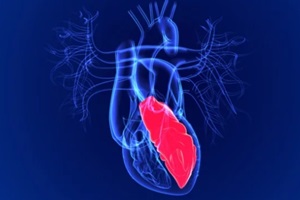[ad_1]
If you have struggled to control your blood pressure, an echocardiogram test may provide important insights into the effects high blood pressure has already caused in your heart.
It’s a safe and painless ultrasound test that gives healthcare providers a clearer picture of a patient’s heart structure and function.
This information helps guide treatment decisions to protect your heart health over the long term through better blood pressure management.
When Your Doctor May Recommend an Echocardiogram
Professional cardiology associations provide treatment guidelines to doctors, nurses, and other practitioners for properly diagnosing and managing high blood pressure, also called hypertension.
Organizations such as the European Society of Cardiology (ESC) and the American Heart Association (AHA) base their expert consensus opinions and recommendations on extensive research.
They agree echocardiogram testing has an important role in caring for patients with difficult-to-control high blood pressure.
Your provider may order an echocardiogram if:
- You have signs of heart problems potentially caused by long-term elevated blood pressure. An echocardiogram can detect subtle changes missed in a routine exam.
- You develop symptoms of possible heart failure, such as shortness of breath, fatigue, or swollen legs or feet. Imaging tests help determine if hypertension has reduced your heart’s pumping ability.
- Your doctor wants more precision in predicting your risk of future cardiovascular disease events such as heart attack or stroke. An echocardiogram provides additional clarity on top of standard risk score calculators.
How an Echocardiogram Helps with Blood Pressure Management
So, what role does an echocardiogram play when it comes to blood pressure management? Here’s how this test can help you when it comes to your cardiovascular health.
Detecting Left Ventricular Hypertrophy
The left ventricle is your heart’s main pumping chamber. Over time, working against higher pressure can stimulate the muscle to grow bigger and thicker.
 This compensatory response, known as left ventricular hypertrophy (LVH), normalizes the added workload. However, it also leads to decreased heart compliance and puts you at higher risk of dangerous heart rhythm abnormalities and heart failure.
This compensatory response, known as left ventricular hypertrophy (LVH), normalizes the added workload. However, it also leads to decreased heart compliance and puts you at higher risk of dangerous heart rhythm abnormalities and heart failure.
Fortunately, studies show properly controlled blood pressure can reverse LVH. An echocardiogram reliably diagnoses LVH earlier than other modalities.
It also characterizes the specific shape and distribution of thickening. This helps predict which patients are most likely to benefit from intensive medical therapy targeting fibrosis and other detrimental effects of hypertension on the heart.
Checking Systolic Pumping Function
Echocardiography helps evaluate how forcefully your left ventricle pumps out blood each beat, known as systolic function. Reduced pumping strength causes symptoms such as fatigue, cough, and swelling. And it independently raises cardiovascular risk even with normal blood pressure.
An echocardiogram accurately quantifies ejection fraction, the percentage of blood emptied from the filled ventricle with each contraction. Values below around 40% often warrant specialist referral and advanced therapies.
For borderline or preserved systolic function, advanced echocardiographic techniques such as strain imaging detect early subtle impairment not visible on standard tests. This prompts more aggressive efforts to shield the heart from ongoing damage.
Assessing Diastolic Relaxation and Filling
Between contractions, when the heart refills with blood, the ventricles must relax fully. Stiffening of the heart muscle from hypertension hampers this process called diastolic function.
Blood then backs up into the lungs, causing shortness of breath. Diastolic dysfunction also reduces cardiac output. Several echocardiographic signs reflect diastolic function, including left atrial size, mitral valve blood flow velocities, and pulmonary venous patterns.
Tissue Doppler and deformation imaging provide additional insights. Providers integrate this information with clinical status to guide therapy.
For example, doctors must find the right blood pressure target that is low enough to reverse left ventricular hypertrophy over time, but not so low that it causes problems with diastolic blood pressure and filling of the ventricles.
Setting the optimal target blood pressure requires balancing these two competing goals.
Screening for Secondary Effects
Besides direct myocardial damage, hypertension strains the entire cardiovascular system. Echocardiography assists in screening for associated issues like:
 Pulmonary hypertension signaled by high pulmonary artery pressure. This increases right ventricle workload and worsens heart failure symptoms.
Pulmonary hypertension signaled by high pulmonary artery pressure. This increases right ventricle workload and worsens heart failure symptoms.- Left atrial enlargement, indicating chronically elevated left heart filling pressures. This may prompt rhythm monitoring to reduce stroke risk.
- Aortic dilation and valve abnormalities, reflecting vascular aging processes accelerated by hypertension. This guides recommendations for other testing or surgery to prevent dangerous complications such as rupture or acute valve failure.
Make the Sound Choice for Your Heart Health Plan with Imperial Center Family Medicine
Modern ultrasound technology provides a detailed window into the heart’s response to hypertension without needles, radiation, or hospital stays. This powerful tool guides therapy to reverse damage and monitor effectiveness.
Imperial Center Family Medicine’s highly experienced team of healthcare providers will partner with you to help you achieve effective blood pressure management.
We employ advanced echocardiography and other diagnostics to create personalized care plans targeting the factors impacting your health.
Contact us today at 919-873-4437 or online so our team can help you improve your cardiovascular health.
[ad_2]
Source link
